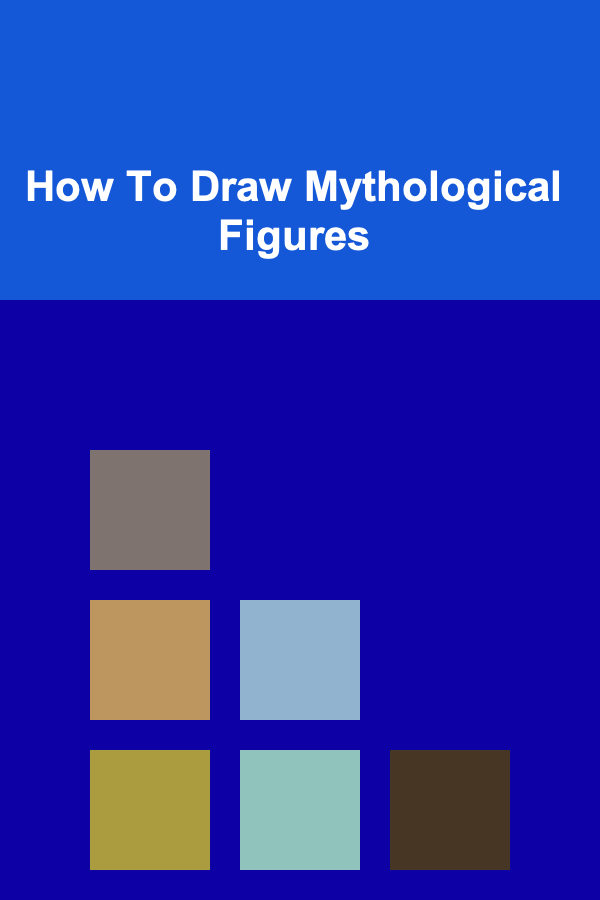
How To Draw Mythological Figures
ebook include PDF & Audio bundle (Micro Guide)
$12.99$11.99
Limited Time Offer! Order within the next:

Drawing mythological figures offers artists a chance to combine creativity, history, and imagination into compelling visual art. These figures, often representing gods, heroes, and legendary creatures from various cultures, come with a wealth of symbolism, traits, and distinctive features that can challenge and inspire artists. The process of drawing these figures is not just about technical skill but also an understanding of the cultural significance and narrative background that makes them unique. In this article, we will explore the techniques and considerations involved in drawing mythological figures, offering step-by-step insights on how to bring these ancient, often fantastical beings to life.
Understanding Mythological Figures
Mythological figures have been a source of storytelling and art for centuries. They serve as symbolic representations of human emotions, divine power, and moral lessons. Each culture has its pantheon of gods, heroes, and monsters, and the way these figures are depicted varies widely based on cultural influences, artistic traditions, and the medium used.
Categories of Mythological Figures
- Gods and Deities: These are the higher beings that govern the universe, control natural forces, and embody specific aspects of life. Examples include Zeus from Greek mythology, Odin from Norse mythology, and Vishnu from Hindu mythology.
- Heroes and Mortals: Many myths involve mortal figures who are endowed with extraordinary abilities. These figures are often tasked with epic quests and trials. Think of Hercules from Greek mythology, Beowulf from Anglo-Saxon folklore, or King Arthur from Arthurian legend.
- Monsters and Creatures: Mythologies often feature terrifying creatures with human or animal-like features. For example, the Minotaur in Greek mythology, the Naga in Hindu and Buddhist mythology, or the Kitsune in Japanese folklore.
- Spirits and Demons: These figures often exist in liminal spaces, between the realms of the living and the dead. They might be malevolent, like the demons in Judeo-Christian traditions, or benevolent spirits, like the kami in Shinto.
Understanding these categories helps to define the characteristics of the figures you're drawing and informs the artist about how to approach their depictions, especially in terms of posture, attire, and expression.
Researching Mythological Figures
Before beginning to draw mythological figures, a critical first step is research. Knowing the historical and cultural context of a figure will help bring authenticity to your representation. Each mythological character has specific traits, attire, and symbols associated with them.
Step 1: Choose Your Figure
Select a figure that resonates with you or one that offers a unique challenge. Researching the figure's origin, powers, and symbolism will help you understand their role in mythology and give you insights into how they are usually portrayed.
Step 2: Study References
Mythological figures have been drawn and painted for centuries. Look at how artists through history have approached these figures. Classic artwork, ancient sculptures, and modern interpretations can offer a wealth of visual reference material. Whether it's the intricate armor of a Norse god or the flowing robes of a Greek deity, these references will inform your design.
Some useful resources include:
- Ancient Art and Sculpture: Museums, archaeological sites, and historical art books.
- Literature and Texts: Reading the myths, epic poems, and plays can give you deeper insight into the character's story and qualities.
- Modern Interpretations: Look at modern takes on mythological figures in books, films, and video games for creative inspiration.
The Drawing Process
Once you have an understanding of the figure and its context, it's time to start the drawing process. Drawing mythological figures combines the same fundamental techniques used in drawing any figure but with added complexity due to the specific cultural and imaginative elements.
Step 1: Sketch the Basic Shape
Start with basic geometric shapes to sketch the figure's proportions and pose. The human body, or any anthropomorphic form, follows general proportions that should be adhered to in the initial stages.
- Pose and Anatomy: If the figure is human-like, begin with a stick figure or simple shapes to define the posture. Mythological figures often depict exaggerated forms---large muscles, towering stature, or dramatic gestures---that reflect their power or divine nature. Heroes like Hercules are often drawn with enhanced muscles, while gods may have symmetrical, idealized forms.
- Guidelines: Use guidelines to place the figure's body parts correctly. These lines will help you maintain proportions, even if the figure is supposed to have supernatural or otherworldly features.
Step 2: Refine the Outline
After establishing the basic structure, begin refining the figure. Focus on creating a clear silhouette that matches the character's identity. For example:
- A warrior god like Ares might have a strong, aggressive posture.
- A divine being like Aphrodite would have a graceful, elegant posture, often with flowing lines.
- A creature such as a centaur will require attention to the creature's unique half-human, half-animal anatomy.
As you move to this stage, it's important to focus on anatomical accuracy. Even though mythological figures are fantastical, understanding human anatomy will help make your drawing more dynamic and believable.
Step 3: Add Detailed Features
At this point, begin adding the distinctive features that define the figure. Some elements to consider:
- Facial Features: Pay attention to the character's facial expression and emotions. Gods, for example, often have serene, powerful faces, while creatures like dragons or monsters are depicted with fearsome, intense expressions.
- Hair and Eyes: The hair might be flowing and otherworldly, or wild and untamed. Eyes can be large, luminous, or unnaturally colored to reflect supernatural traits.
For a figure like Medusa, the character's snake-like hair could take up a large portion of the image and should be rendered with care, perhaps making use of dramatic, swirling lines to show movement.
Step 4: Clothing, Armor, and Accessories
Mythological figures often wear garments or armor that reflect their roles or powers. Consider the following when adding these elements:
- Armor: Gods of war, such as Athena or Mars, often wear intricate armor that symbolizes their strength and tactical nature.
- Ritual Clothing: Deities or spiritual beings may be adorned in robes or clothes that emphasize purity or celestial status.
- Weapons: Many mythological figures carry symbolic weapons, such as swords, spears, or staffs. These weapons carry meaning and should reflect the figure's power or role.
Use texture and shading to make clothing and armor look realistic. For instance, when drawing intricate armor, think about how light plays off the surfaces, creating shadows and highlights that bring depth to the design.
Step 5: Add Symbolic Elements
A key aspect of mythological figures is their symbolism. These symbols often appear in the form of:
- Attributes: Many gods and mythical creatures are associated with specific items (e.g., Zeus's thunderbolt, Poseidon's trident, or Hecate's torch). Incorporating these objects adds depth to the story behind the figure.
- Nature Elements: Certain deities or figures have strong connections to the natural world. For example, Artemis is often depicted with animals or hunting tools, while Demeter is associated with plants and harvest.
- Mythological Creatures: If your figure is a creature, like a griffin or sphinx, focus on blending animal features with human traits in a harmonious or dramatic way.
Step 6: Add Shading and Details
Once the figure is outlined, the next step is adding depth. Begin with basic shading to give the drawing volume. Use hatching and cross-hatching for texture, keeping in mind the light source. Mythological figures often have larger-than-life qualities, so shading should enhance the drama of their presence.
- Light and Shadow: Decide where the light source is coming from and use shadows to create a sense of dimensionality. Divine or supernatural figures might have an ethereal glow, so using highlights around the figure could convey this effect.
- Texture: Clothing, skin, hair, and other materials should have textures that enhance the realism or stylized nature of the drawing. Use different techniques to create the look of different materials like stone, fabric, or skin.
Step 7: Finishing Touches
Finally, review your drawing and make any necessary adjustments. This could involve enhancing details, refining proportions, and adding additional highlights. The final touches will ensure the character's personality and mythology shine through, making your drawing not just a figure but a storytelling piece.
Conclusion
Drawing mythological figures offers a unique opportunity to combine historical knowledge with artistic creativity. By understanding the cultural significance, symbolism, and distinctive traits of these figures, artists can create powerful and meaningful representations that connect with audiences on a deep level. Through careful research, understanding anatomy, and focusing on detailed features and symbolism, artists can breathe life into these ancient and legendary beings, keeping their myths alive through the art of drawing.
Whether you are a beginner or an experienced artist, remember that each drawing is a journey---one that combines both technical skill and a deep appreciation for the myths that continue to inspire and shape cultures around the world.

How to Build a Strong Brand for Your Pet Supplies Dropshipping Store
Read More
How to Develop a Marketing Plan for Your New Business
Read More
How to Protect Your Investments from Inflation
Read More
How to Protect Your Rental Property from Natural Disasters
Read More
Understanding the Role of Community in Gaming
Read More
Choosing the Right Carpet Rake: A Comprehensive Guide
Read MoreOther Products

How to Build a Strong Brand for Your Pet Supplies Dropshipping Store
Read More
How to Develop a Marketing Plan for Your New Business
Read More
How to Protect Your Investments from Inflation
Read More
How to Protect Your Rental Property from Natural Disasters
Read More
Understanding the Role of Community in Gaming
Read More